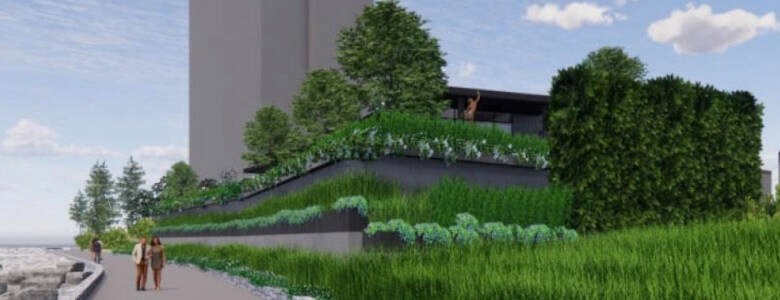A concrete retaining wall that will rise 13 feet high right beside the West Vancouver Centennial Seawalk in Dundarave has been approved by council.
District of West Vancouver council voted 5-1 Monday night to approve the wall being built on a waterfront property at 2368 Bellevue Ave. to protect the property from storm surges and the impacts of sea level rise.
The wall – which will be built nine feet taller than is currently allowed – attracted significant controversy over the past month, with some members of the public arguing that the wall will be a visual eyesore and set a precedent for other waterfront property owners to build tall walls next to the Seawalk.
Others said the new home that will be built on the property and the landscaping the owners are proposing will be an improvement over what is currently on the site.
Property co-owner Janice O’Sullivan told council the issue has become an emotional one over the past month, with a petition circulating against the proposal, and some suggesting the wall was mainly to provide privacy for a swimming pool that was part of the original plan.
Co-owner Phil Cotterill said the swimming pool has since been eliminated from the plans as the cost was too high.
“We’re not going to build a swimming pool,” he said.
The owners said the wall is being built to comply with provincial flood protection rules, now incorporated into the district’s development permit guidelines, which take into account anticipated sea level rise up to the year 2100.
Coun. Scott Snider said it “seems extreme” to force homeowners to build to a worst-case scenario 75 years in the future.
Coun. Sharon Thompson added that building to those guidelines has inevitably created upset within existing waterfront neighbourhoods and “unfortunately, it often makes it look like the person building is the bad guy,” she said.
District staff recommended rejecting the variance request for the wall, and instead asking the property owners to come back with a plan involving terraced retaining walls that gradually step back from the Seawalk.
“There are other options in configuring the property,” said Jim Bailey, director of planning.
Coun. Nora Gambioli said that would be her preferred option.
But the owners said that would involve essentially losing a large chunk of their property to potential storm impacts.
John Davis, a regular Seawalk user and friend of the owners, spoke in favour of the proposal.
“These people are doing what we would all do – request a reasonable compromise,” he said.
Debbie Evans, who lives in the neighbouring Seastrand building, said “once it’s designed and finished, you won’t notice it.”
Not everyone agreed, however, with a few letter writers suggesting once one wall is allowed, a number of other property owners would follow suit.
Martine Dekeyn said she believes the wall will destroy the atmosphere along the Seawalk and “disrupt the entire ambience of the neighbourhood,” arguing any design should fit in with existing buildings.
Jan McCaffrey argued that the vertical wall was not the only option.
“It’s the wall design that I have an issue with. It’s a lot of concrete,” she said.
“It looks like a corporate headquarters was dropped on the beach” she said, describing it as a 160-foot long “concrete edifice.”
Coun. Christine Cassidy said she supports the wall construction but was mostly concerned about future upkeep of plantings to soften the appearance of the wall, should owners opt to sell in the future. Cassidy said she’d rather the wall resemble “the Hanging Gardens of Babylon” than “the Berlin Wall.”
Gambioli opposed the wall construction.
“I think that’s really an overreach into the public sphere, and I really don’t think this design of this wall is the legacy that I want to leave to the community,” she said.
Council eventually voted to approve the wall construction, with the inclusion of a covenant requiring proper maintenance of the wall – with Gambioli opposed. Coun. Peter Lambur was absent from the meeting.



